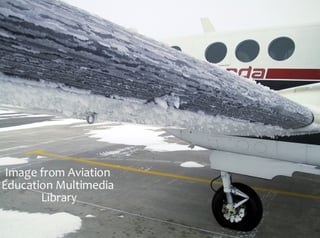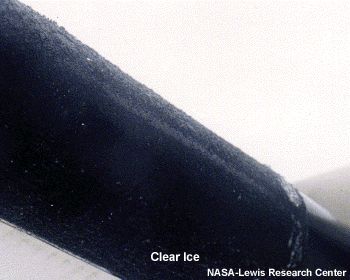I've seen some reports that say ice forms on the back half of the wing and on the outside edge of the wing (the part furthest from the body) before it will form anywhere else. I'm wondering if this is true? Where does ice first form on a wing (in flight) in icing conditions?
1 Answer
"Icing conditions" is a pretty vague term that encompasses a lot of various situations that can cause airframe icing (AOPA pdf report, so it's hard to have one definitive answer. That said, you can expect to accumulate some degree of ice when flying through moisture (clouds, rain, etc) when outside air temperatures (OAT) are near or below 36°F / 2°C. Also as a rule, an aircraft's tail will likely accumulate ice faster than the wing in all conditions.
Flying through very cold temperatures (-15°C -> -40°C)
When flying in clouds and rain at the very low end of the icing spectrum, the most likely form of accumulation is rime icing. This primarily forms on the leading edges of wings and tail surfaces, starting (in most cases) with the tail, and looks (initially, at least) a lot like frost. It can create pretty bizarre structures and is pretty easy to spot. Rime ice is (as far as I have seen or read) not going to accumulate anywhere but on leading edges (wings, nose, engine nacelles, tail) as those are the only parts of the structure impacting the relative wind. Either way, it is highly detrimental to your wing's aerodynamic health.
Rime ice can sometimes form 'horns' that start to grow in a V shape forward off the wing, but only in what I imagine are considered severe conditions. The FAA states that rime "typically occurs with temperatures between -15° C. and -20 ° C".

Flying in relatively warm temperatures (2°C -> -15°C)
At warmer temps, the most likely form is clear ice, which is basically like having solid water ice form around the leading edges - again, wings, tail surfaces, nose, engines. It pretty much follows the shape of the leading edge of surface it freezes onto, but it's heavy and still messes with your aerodynamics. Again, like rime, it's freezing more or less on impact (but with larger droplets) wherever the relative wind strikes the airframe.
In some unusual conditions, aircraft can encounter precip known as Supercooled Large Droplets (SLD); these are cold enough to freeze but not on impact, causing a form of icing known as runback ice (FAA pdf). In FAA tests, "ice shape simulations were found to cause substantial penalties to the aerodynamic performance" of multiple NACA airfoils. Runback ice can accumulate pretty far back along a wing, making it difficult or impossible to dislodge using heat or boots (supposedly TKS fluid protection can mitigate this). It's scary stuff.
The FAA states that "Clear ice typically forms when temperatures are around 2° C to -10°C [but] more hazardous clear ice shapes [...] tend to form at temperatures closer to 0°C".

Flying in medium temperatures (-10°C -> -15°C)
When flying in the middle of the temperature range, aircraft wind up accumulating mixed ice, a combination of rime and clear. According to the FAA, "Mixed ice is most likely to form at temperatures between -10° C to -15° C". It is basically as terrible for aerodynamics as rime ice, and pretty much just as heavy as clear ice. No fun.
Resources:
-
$\begingroup$ "Also as a rule, an aircraft's tail will likely accumulate ice faster than the wing in all conditions." Do you have a reasoning, or source to support this? $\endgroup$ Commented Jun 5, 2015 at 7:01
-
1$\begingroup$ Yeah, the AOPA document mentions it. The thinner the airfoil the faster ice accumulates, and the more susceptible the airfoil is to the negative effects. Plenty of accident records with tail plane icing causing a tail stall, leading to a deep stall. $\endgroup$– egidCommented Jun 5, 2015 at 8:01
-
$\begingroup$ Thanks! I get the second argument, but why would a thinner airfoil accumulate ice faster? Is it because it has less thermal mass (also because the wing is filled with fuel?)? $\endgroup$ Commented Jun 5, 2015 at 8:04
-
$\begingroup$ I think it has to do with the thickness of an airfoil changing the air mass striking the surface around the stagnation point although I admit my aerodynamics knowledge is not mathematical enough to explain why. @PeterKämpf may know what's up. $\endgroup$– egidCommented Jun 5, 2015 at 8:08
-
1$\begingroup$ @egid Great answer. For the most "common" balance distributions (AC behind CG), wouldn't the tail stall actually cause a violent pitch-down instead of a deep stall? ("Classic" scenario: High wing, conventional tail aircraft extending flaps, moving CP aftwards, increasing the downwash on the stab, stalling it, pitch-up moment from stab decreases -> aircraft pitches down -> angular pitch velocity serves to deepen the stall of the stab -> da capo al fin) $\endgroup$– WakedCommented Jun 5, 2015 at 15:02
